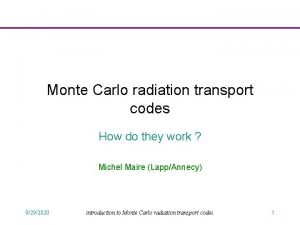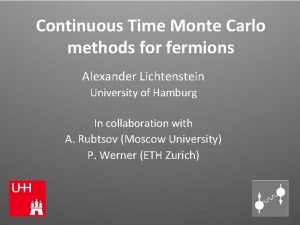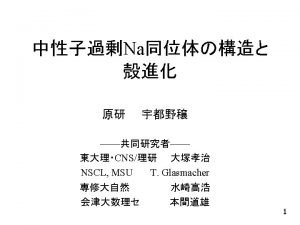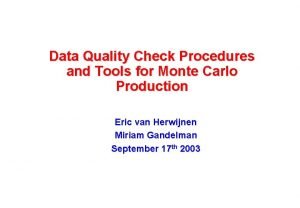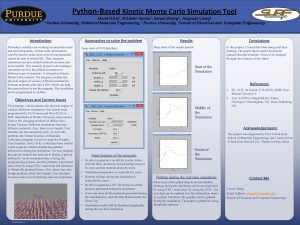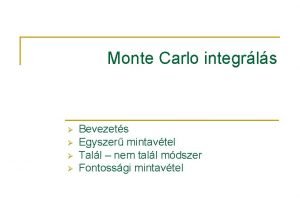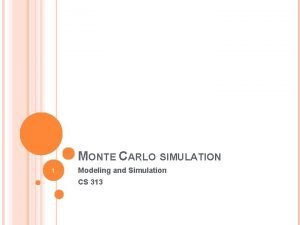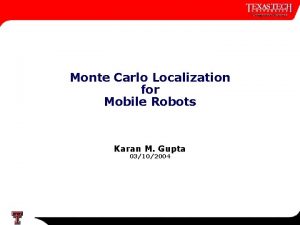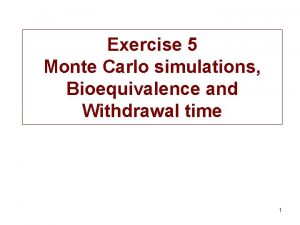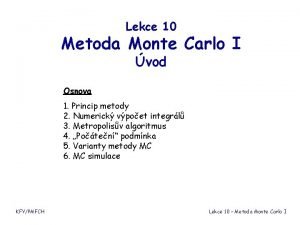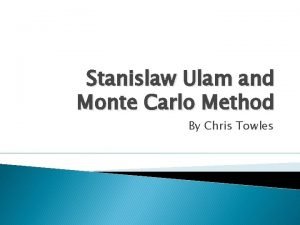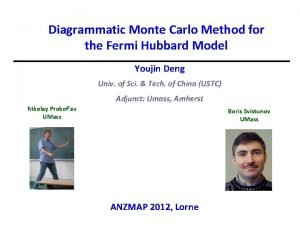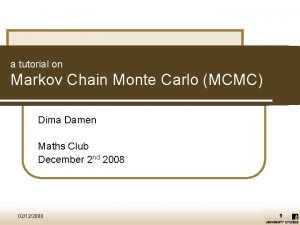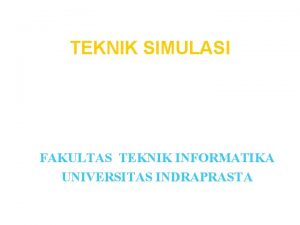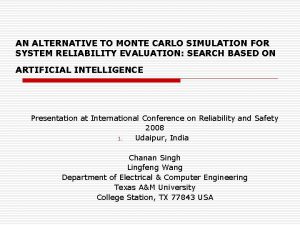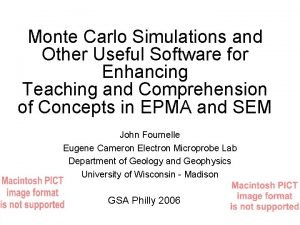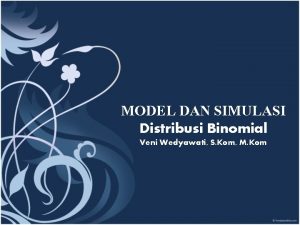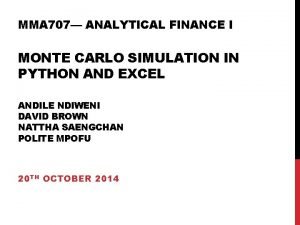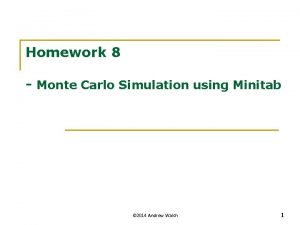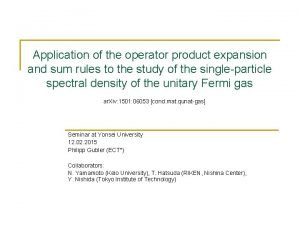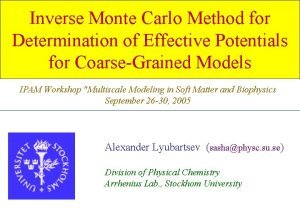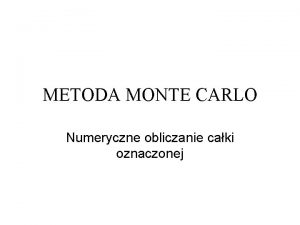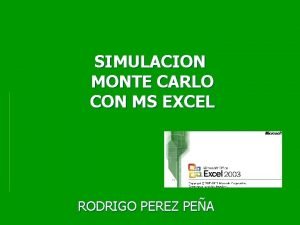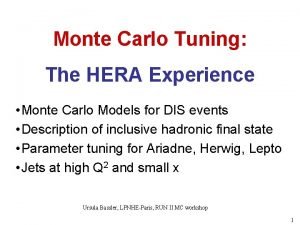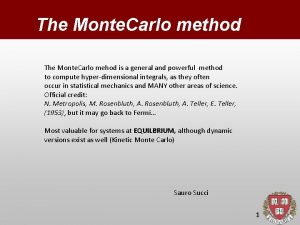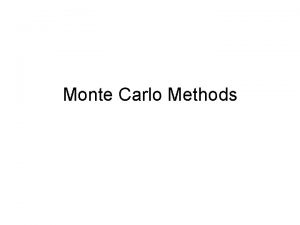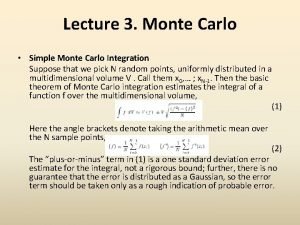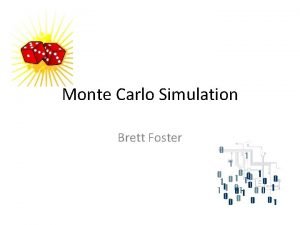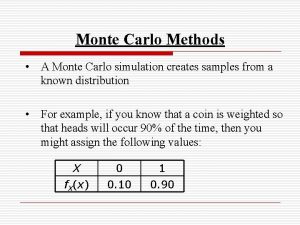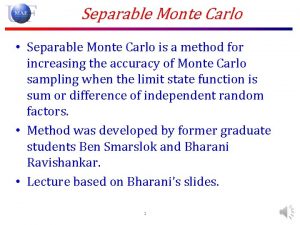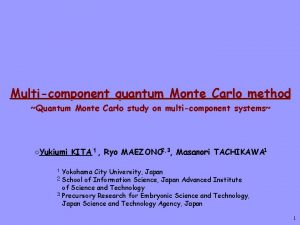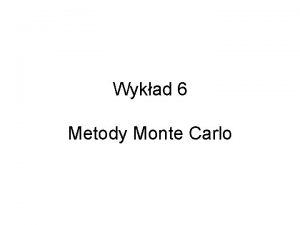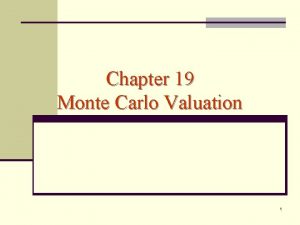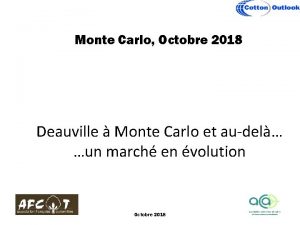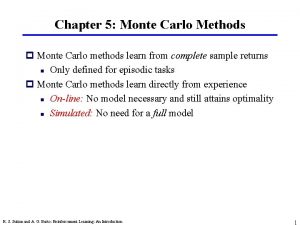Monte Carlo radiation transport codes How do they




















![Ionization (4) straggling : DE = [DE] + fluctuations e- 16 Me. V in Ionization (4) straggling : DE = [DE] + fluctuations e- 16 Me. V in](https://slidetodoc.com/presentation_image/9801d5f78457c25db3b73ab08c34ad55/image-21.jpg)




- Slides: 25

Monte Carlo radiation transport codes How do they work ? Michel Maire (Lapp/Annecy) 9/29/2020 introduction to Monte Carlo radiation transport codes 1

Decay in flight (1) l An unstable particle have a time of life t initial momentum p ( velocity v ) distance to travel before decay AB = d 1 = t v v A (non relativist) • Geometry : the particle is inside a box. compute distance to boundary AC = d 2 • Transport the particle s = min (d 1, d 2) • if C < B : do nothing in C, but compute the time spent in flight : Dt = AC/v if B < C : decay the particle 9/29/2020 d 2 A introduction to Monte Carlo radiation transport codes B d 1 B C 2

Geometry (1) l l The apparatus is described as an assembly of volumes made of homogene Volumes can be embeded or assembled with boulean operations A A B B C C D E • when travelling inside the apparatus, the particle must know : • where I am ? locate the current volume • where I am going ? compute distance to next boundary 9/29/2020 introduction to Monte Carlo radiation transport codes 3

Geometry (2) l remember : a computer program in blind … A A . p B B C C D E • where I am ? locate the current volume • where I am going ? compute distance to next boundary example : a point P in a box p 9/29/2020 compute intersections with 6 planes introduction to Monte Carlo radiation transport codes 4

Decay in flight (2) • The time of life, t, is a random variable with probability density function : f(t) t • It can been demonstrated in a general way that the cumulative distribution function is itself a random variable with uniform probability on [0, 1] therefore : 1 - choose r uniformly random on [0, 1] 2 - compute t = F-1(r) • For the exponential law, this gives : t = -t ln(1 - r) = -t ln(r’) 9/29/2020 introduction to Monte Carlo radiation transport codes 5

Decay in flight (3) v l When the particle travel on a distance d, one must update thedelapsed. B time A t (t – d/v) • When t = 0, one must trigger the decay of the particle • • • for instance p 0 g g (~ 99%) g e+ e- (~1%) 0 0. 99 Select a channel according the branching ratio choose r uniformly on [0, 1] p q Generate the final state • • in the rest fram of the p 0 : d. W = sinq dq df apply Lorentz transform 9/29/2020 introduction to Monte Carlo radiation transport codes 6 1

Decay in flight : comments l the generation of the whole process needs at least 4 random numbers l the decay is the simplest but general scheme of the so called analogue Monte Carlo transport simulation 9/29/2020 introduction to Monte Carlo radiation transport codes 7

Compton scattering (1) g+ e- g + e. The distance before interaction, L, is a random variable g g L e- • η(E, ρ) is the probability of Compton interaction per cm • λ(E, ρ) = η-1 is the mean free path associated to the process (Compton) Sample l = -λ ln(r) with r uniform in [0, 1] 9/29/2020 introduction to Monte Carlo radiation transport codes 8

Compton scattering (2) l l l(E, r), and l, are dependent of the material one define the number of mean free path : l l 1 l 2 l 3 • nl is independent of the material and is a random variable with distribution : f(nl) = exp(-nl) • sample nl at origin of the track : nl = -ln(r) • update elapsed nl along the track : nl (nl – dli / li) • generate Compton scattering when nl = 0 9/29/2020 introduction to Monte Carlo radiation transport codes 9

Compton scattering (3) g • Let define : E 0 q e- • the differential cross section is : • sample e with the ‘acceptation-rejection’ method remark : the generation of the whole Compton scattering process needs at least 5 random numbers 9/29/2020 introduction to Monte Carlo radiation transport codes 10

MC : acceptation-rejection method (1) l • l l • • let f(x) a probability distribution. S 1 the surface under f assume we can enclose f(x) in a box ABCD, of surface S 0 choose a point P(x 1, y 1) uniformly random within S 0 accept P only if P belong to S 1 x will be sample according to the probability distribution f the envelope can be a distribution function e(x) simple enough to be sampled with inversion technique In this case x in sampled with e(x) and rejected with f(x) 9/29/2020 y D C f(x) S 0 y 1 P S 1 A x 1 x B y e(x) f(x) y 1 P A S 1 x 1 introduction to Monte Carlo radiation transport codes x B 11

MC : acceptation-rejection method (2) l assume that we can factorize : P(x) = K f(x) g(x) • • • f(x) : probability distribution simple enough to be inverted g(x) : ‘weight’ function with values in [0, 1] K > 0 : constant to assure proper normalization of f(x) and g(x) step 1 : choose x from f(x) by inversion method step 2 : accept-reject x with g(x) • even : P(x) = K 1 f 1(x) g 1(x) + K 2 f 2(x) g 2(x) + … step 0 : choose term i with probability Ki 9/29/2020 r 2 1 g(x) r 2 P A 0 B x x r 1 F(x) 1 r 1 introduction to Monte Carlo radiation transport codes 12

g 10 Me. V in Aluminium 9/29/2020 introduction to Monte Carlo radiation transport codes 13

Simulation of charged particles (e-/+) l l Deflection of charged particles in the Coulomb field of nuclei. • small deviation; pratically no energy loss In finite thickness, particles suffer many repeated elastic Coulomb scattering • > 106 interactions / mm The cumulative effect is a net deflection from the original particle direction Individual elastic collisions are grouped together to form 1 multiple scattering single atomic deviation macroscopic view condensed history technique (class 1 algorithms) 9/29/2020 introduction to Monte Carlo radiation transport codes 14

Multiple Coulomb scattering (1) l l longitudinal displacement : z (or geometrical path length) lateral displacement : r, F true (or corrected) path length : t angular deflection : q, f 9/29/2020 introduction to Monte Carlo radiation transport codes 15

Multiple Coulomb scattering (2) 9/29/2020 introduction to Monte Carlo radiation transport codes 16

Multiple Coulomb scattering (3) 50 mm Tungsten 10 e 600 ke. V 9/29/2020 introduction to Monte Carlo radiation transport codes 17

Ionization (1) A charged particle hits a quasi-free electron (d-ray) p E 0 e- T e- cut p Tmax 9/29/2020 introduction to Monte Carlo radiation transport codes T 18

Ionization (2) accounted in the condensed history of the incident particle d. E/dx is called (restricted) stopping power or linear energy transfered explicit creation of an e- : analogue simulation 9/29/2020 introduction to Monte Carlo radiation transport codes 19

Ionization (3) ‘hard’ inelasic collisions d-rays emission e- 200 Me. V proton 200 Me. V a 200 Me. V 1 cm Aluminium 9/29/2020 introduction to Monte Carlo radiation transport codes 20
![Ionization 4 straggling DE DE fluctuations e 16 Me V in Ionization (4) straggling : DE = [DE] + fluctuations e- 16 Me. V in](https://slidetodoc.com/presentation_image/9801d5f78457c25db3b73ab08c34ad55/image-21.jpg)
Ionization (4) straggling : DE = [DE] + fluctuations e- 16 Me. V in water ( muls off ) 9/29/2020 introduction to Monte Carlo radiation transport codes 21

Condensed history algorithms group many charged particles track segments into one single ‘condensed’ step discrete collisions grouped collisions • • • elastic scattering on nucleus • multiple Coulomb scattering soft inelastic collisions • collision stopping power (restricted) soft bremsstrahlung emission • • ‘hard’ d-ray production • energy > cut ‘hard’ bremstrahlung emission • energy > cut positron annihilation radiative stopping power (restricted) 9/29/2020 introduction to Monte Carlo radiation transport codes 22

Principle of Monte Carlo dose computation • Simulate a large number of particle histories until all primary and secondary p • Calculate and store the amount of absorbed energy of each particle in each r • The statistical accuracy of the dose is determined by the number of particle h 9/29/2020 introduction to Monte Carlo radiation transport codes 23

A non exhaustive list of MC codes (1) l l ETRAN (Berger, Seltzer; NIST 1978) EGS 4 (Nelson, Hirayama, Rogers; SLAC 1985) www. slac. stanford. edu/egs l EGS 5 (Hirayama et al; KEK-SLAC 2005) rcwww. kek. jp/research/egs 5. html l EGSnrc (Kawrakow and Rogers; NRCC 2000) www. irs. inms. nrc. ca/inms/irs. html l Penelope (Salvat et al; U. Barcelona 1999) www. nea. fr/lists/penelope. html 9/29/2020 introduction to Monte Carlo radiation transport codes 24

A non exhaustive list of MC codes (2) l Fluka (Ferrari et al; CERN-INFN 2005) www. fluka. org l Geant 3 (Brun et al; CERN 1986) www. cern. ch l Geant 4 (Apostolakis et al; CERN++ 1999) geant 4. web. cern. ch/geant 4 l MARS (James and Mokhov; FNAL) www-ap. fnal. gov/MARS l MCNPX/MCNP 5 (LANL 1990) mcnpx. lanl. gov 9/29/2020 introduction to Monte Carlo radiation transport codes 25
 Monte carlo radiation transport
Monte carlo radiation transport Continuous time monte carlo
Continuous time monte carlo Monte carlo sd
Monte carlo sd Monte carlo data quality
Monte carlo data quality Kinetic monte carlo python
Kinetic monte carlo python Monte carlo search tree
Monte carlo search tree Monte carlo szimuláció példa
Monte carlo szimuláció példa Equilikely
Equilikely Monte carlo localization for mobile robots
Monte carlo localization for mobile robots Monte carlo exercise
Monte carlo exercise Metoda monte carlo
Metoda monte carlo Stanislaw ulam
Stanislaw ulam Diagrammatic monte carlo
Diagrammatic monte carlo Markov chain monte carlo tutorial
Markov chain monte carlo tutorial Contoh soal pembangkit bilangan acak
Contoh soal pembangkit bilangan acak Monte carlo simulation alternative
Monte carlo simulation alternative Connect 4 monte carlo tree search
Connect 4 monte carlo tree search Monte carlo simulation freeware
Monte carlo simulation freeware Ciri distribusi binomial
Ciri distribusi binomial Monte carlo simulation
Monte carlo simulation Monte carlo minitab
Monte carlo minitab Quantum monte carlo
Quantum monte carlo Inverse monte carlo
Inverse monte carlo Simulasi monte carlo ppt
Simulasi monte carlo ppt Metoda monte carlo algorytm
Metoda monte carlo algorytm Distribucion poisson excel
Distribucion poisson excel
